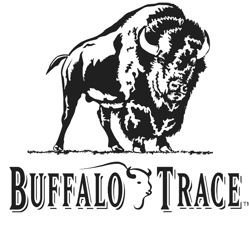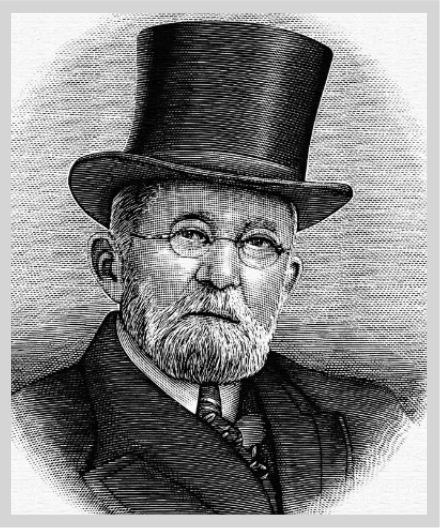Colonel Edmund H. Taylor, Jr.
Sketch Photo of Colonel E. H. Taylor, Jr., provided by Buffalo Trace web site
"The Father of the Modern Bourbon Industry"
Colonel Edmund Haynes Taylor, Jr. was born in Columbus, Kentucky in 1830. Edmund’s father passed away when he was only 5 years old and as a result the young boy was sent to a Louisiana plantation to live with his great uncle Zachary where he received a formal education. At that time Zachary Taylor was a Colonel in the U. S. Army and rose up through the ranks quickly. He established defensive positions and forts along the Mississippi River to insure America’s dominance along the river. Then he made a name for himself fighting Indians in the Black Hawk War.
Young Edmund was a descendant of two U.S. presidents, both James Madison and General Zachary Taylor. Many felt that Edmund was destined for leadership with ambition in his blood. His family had many great legacies; James Madison went down in history as the “Father of the Constitution,” and his great uncle Zachary was known as "Old Rough and Ready" as one of the two Commanding Generals in the Mexican-American War. Edmund H. Taylor lived up to his family history and cemented his own prestigious legacy as the “Father of the Modern Bourbon Industry.” To this day, Taylor is celebrated for the numerous innovations that he either invented, brought to America, improved on or contributed to the bourbon industry during his life.
General Taylor gave the boy a good classical education taking classes at Tulane Preparatory School. In 1851 Taylor returned to Kentucky and moved to Lexington. There he lived with his immediate uncle by the same name, Edmond Haynes Taylor. The older Taylor was a banker by trade and “Jr.” was added to the young Taylor’s name to distinguish him from his uncle. Later that same year Edmund married what was said to be the most beautiful woman in Central Kentucky in Fanny Johnson. The two would go on to have a total of seven children.
Taylor’s occupation as a banker and his relationship to others in the Bourbon industry helped him learn a lot about the trade. He had access to their books, which allowed the bank to lend them money and on occasion had to foreclose. That access gave Edmund a sense that there was money a lot of money to be made in distilling and selling whiskey.
But Edmund didn’t just want to make any whiskey like the many distillers around Kentucky were doing. He wanted to make a quality product, he wanted to make the best Whiskey America had to offer. With his interest peaked and his curiosity running wild, Taylor spent several years after the Civil War touring Europe and being educated in the latest distilling techniques, including the importance of keeping the liquids in copper kettles. When he returned to the United States in late 1867 he opened his first distillery, and called it “The Hermitage" after Andrew Jackson’s Estate.
Just two years later Taylor purchased the Leestown Distillery, just out side Frankfort in 1869 and christened it the, "O.F.C. Distillery (Old Fire Copper) Distillery." This was his first major step he took into distilling and he made an immediate impact on the industry by updating, upgrading and increasing the capacity of the entire plant.
Among his inventions or improvements were using copper fermentation tanks, state-of-the-art grain equipment, column stills, modernized buildings, a more efficient sour mash technique and a first-of-its-kind steam heating system (which is still used in the warehouses today). Although he operated successfully for more than a decade, a combination of factors brought Taylor close to bankruptcy in the late 1870s and forced him to sell control of his distillery to the St. Louis Liquor firm of Gregory and Stagg.
During his later life Taylor was also a skilled politician and was actually elected Mayor of Frankfort for 16 consecutive years. During that time he used his influence to fight for higher standards in the bourbon industry, pushing for the passage of the "Bottled-in-Bond Act of 1897" along with the Secretary of Treasury John Carlisle.
The three brands as part of the E. H. Taylor line that are always available are (from left to right); Colonel E. H. Taylor Small Batch (Orange Tax Stamp), Colonel E. H. Taylor Single Barrel (Burgundy Tax Stamp) and Colonel E. H. Taylor Straight Rye (Red Tax Stamp).
The six brands as part of the E. H. Taylor line that are Limited Edition Releases and are very hard to find are (from left to right); Colonel E. H. Taylor Barrel Proof (Green Tax Stamp), Colonel E. H. Taylor Cured Oak (Burgundy Tax Stamp), Colonel E. H. Taylor Seasoned Wood (Black Tax Stamp), Colonel E. H. Taylor Old Fashioned (Blue Tax Stamp), Colonel E. H. Taylor Warehouse C Tornado surviving (Gray Tax Stamp) and Colonel E. H. Taylor Four Grain (Green Tax Stamp)..
Photos are provided by Buffalo Trace Distillery
Banner photo by BourbonBanter






